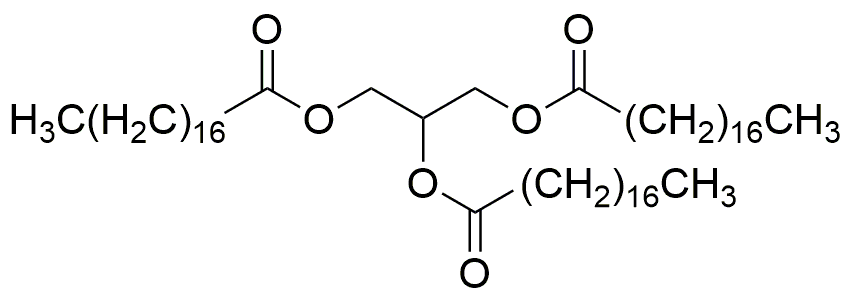Tristearin is widely utilized in research focused on:
- Food Industry: As a triglyceride, it serves as a fat source in various food products, enhancing texture and flavor while providing essential fatty acids.
- Pharmaceuticals: Tristearin is used as an excipient in drug formulations, improving the solubility and bioavailability of active ingredients, which is crucial for effective medication delivery.
- Cosmetics: In skincare products, it acts as an emollient, helping to moisturize and soften the skin, making it a popular choice in lotions and creams.
- Biodegradable Plastics: It is explored as a component in developing eco-friendly packaging materials, contributing to sustainability efforts in the industry.
- Research Applications: Tristearin is used in studies related to lipid metabolism and energy storage, providing insights into biological processes and potential health impacts.
General Information
Properties
Safety and Regulations
Applications
Tristearin is widely utilized in research focused on:
- Food Industry: As a triglyceride, it serves as a fat source in various food products, enhancing texture and flavor while providing essential fatty acids.
- Pharmaceuticals: Tristearin is used as an excipient in drug formulations, improving the solubility and bioavailability of active ingredients, which is crucial for effective medication delivery.
- Cosmetics: In skincare products, it acts as an emollient, helping to moisturize and soften the skin, making it a popular choice in lotions and creams.
- Biodegradable Plastics: It is explored as a component in developing eco-friendly packaging materials, contributing to sustainability efforts in the industry.
- Research Applications: Tristearin is used in studies related to lipid metabolism and energy storage, providing insights into biological processes and potential health impacts.
Documents
Safety Data Sheets (SDS)
The SDS provides comprehensive safety information on handling, storage, and disposal of the product.
Product Specification (PS)
The PS provides a comprehensive breakdown of the product’s properties, including chemical composition, physical state, purity, and storage requirements. It also details acceptable quality ranges and the product's intended applications.
Certificates of Analysis (COA)
Search for Certificates of Analysis (COA) by entering the products Lot Number. Lot and Batch Numbers can be found on a product’s label following the words ‘Lot’ or ‘Batch’.
*Catalog Number
*Lot Number
Certificates Of Origin (COO)
This COO confirms the country where the product was manufactured, and also details the materials and components used in it and whether it is derived from natural, synthetic, or other specific sources. This certificate may be required for customs, trade, and regulatory compliance.
*Catalog Number
*Lot Number
Safety Data Sheets (SDS)
The SDS provides comprehensive safety information on handling, storage, and disposal of the product.
DownloadProduct Specification (PS)
The PS provides a comprehensive breakdown of the product’s properties, including chemical composition, physical state, purity, and storage requirements. It also details acceptable quality ranges and the product's intended applications.
DownloadCertificates of Analysis (COA)
Search for Certificates of Analysis (COA) by entering the products Lot Number. Lot and Batch Numbers can be found on a product’s label following the words ‘Lot’ or ‘Batch’.
*Catalog Number
*Lot Number
Certificates Of Origin (COO)
This COO confirms the country where the product was manufactured, and also details the materials and components used in it and whether it is derived from natural, synthetic, or other specific sources. This certificate may be required for customs, trade, and regulatory compliance.

